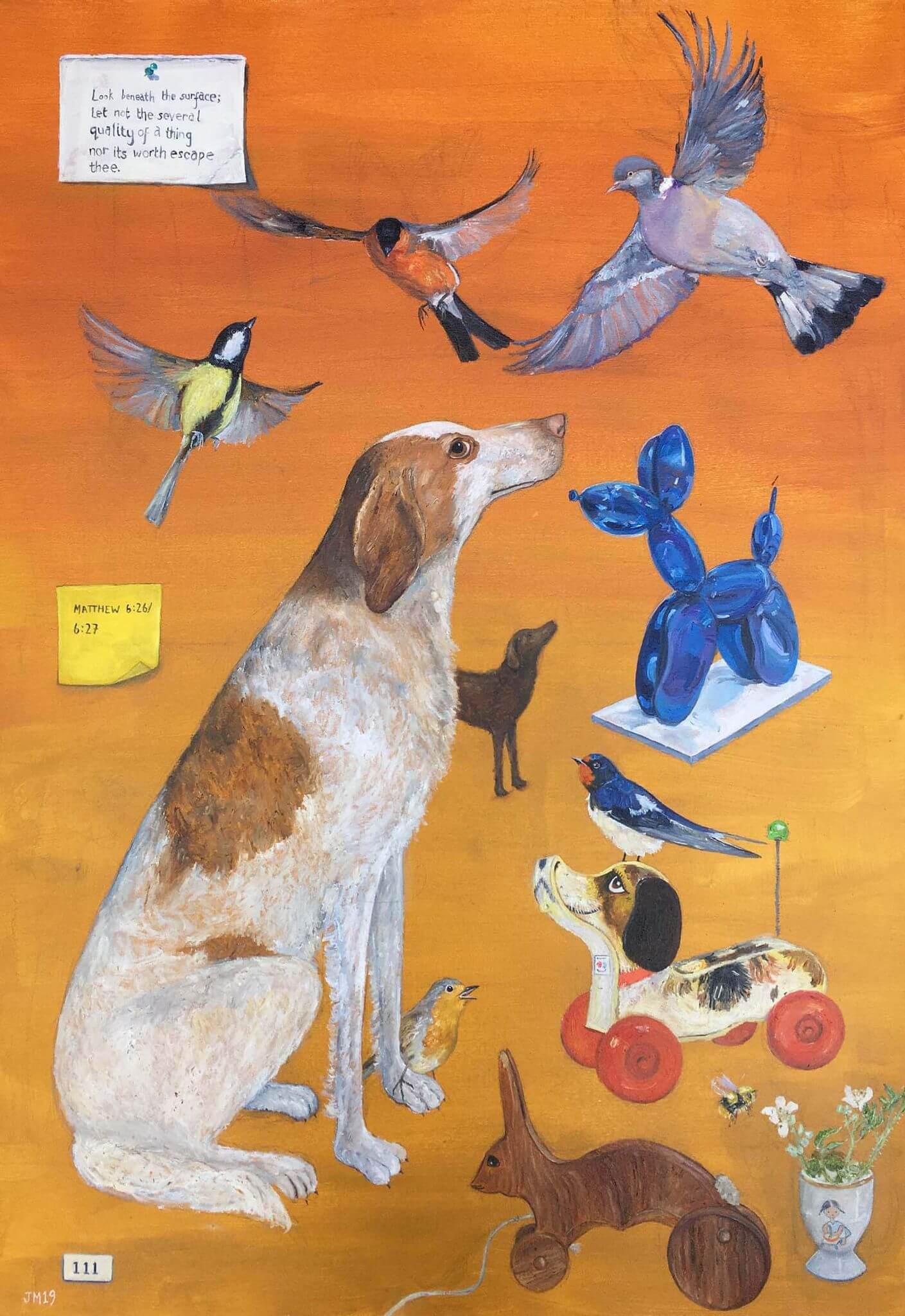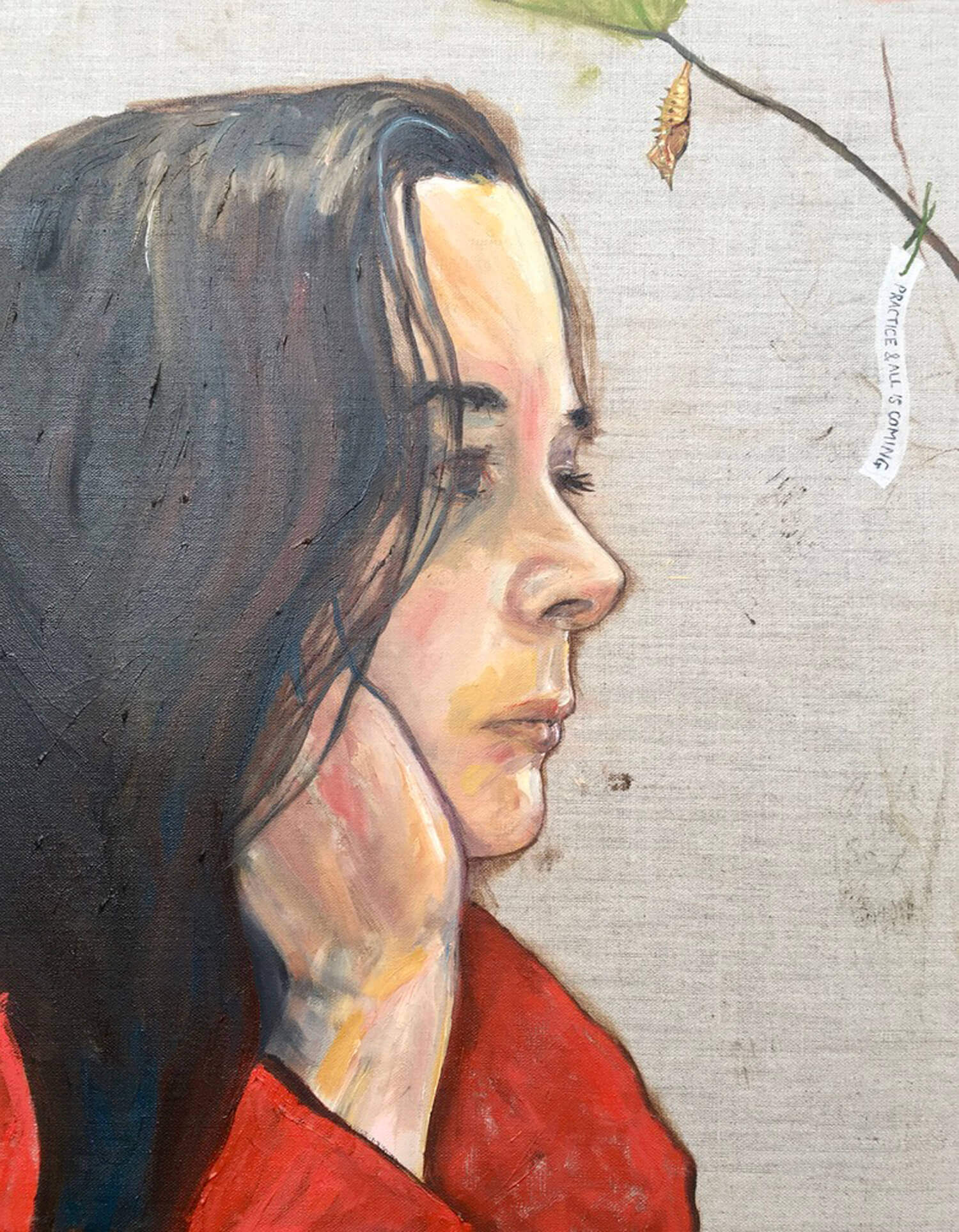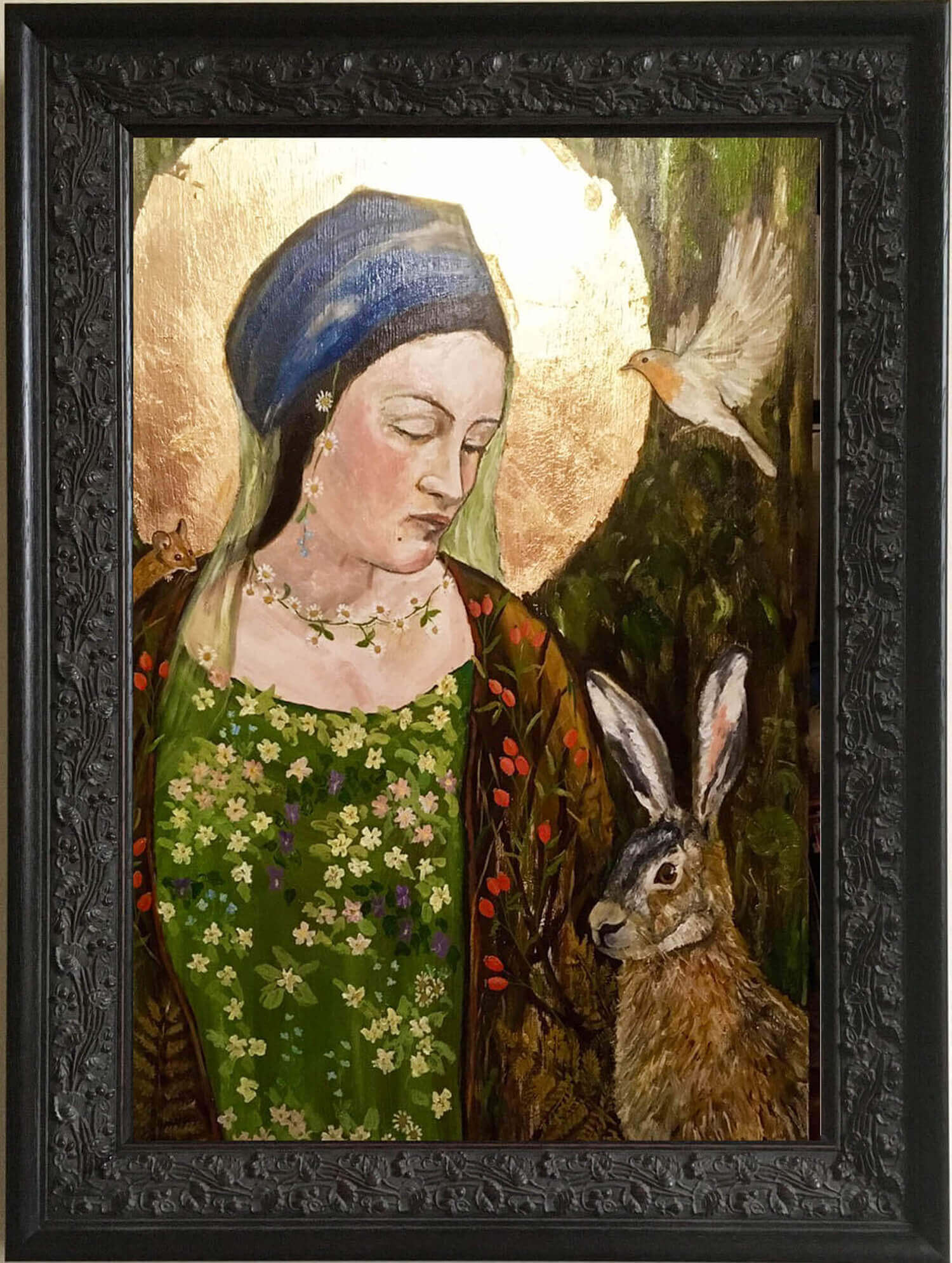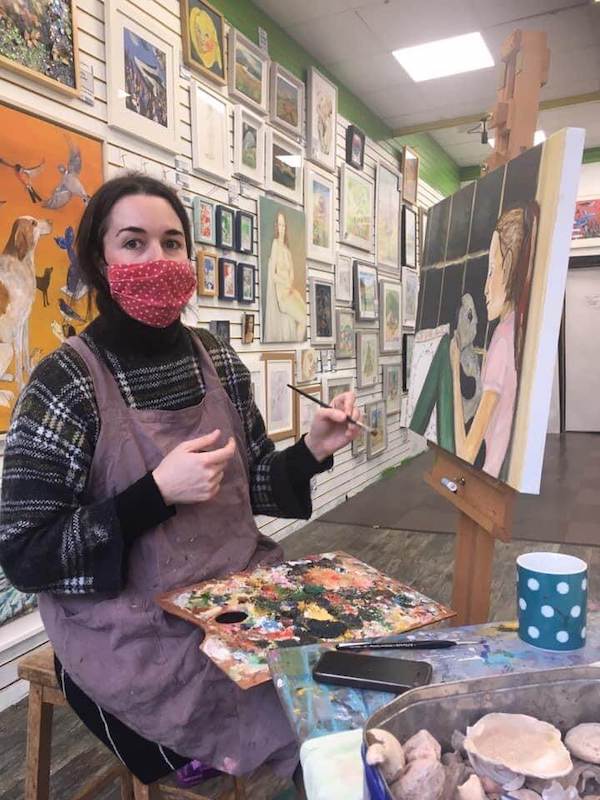Artist Interview with Johanna McWeeney
As part of our, Creative Talk series, we talk to artist Johanna McWeeney.
In this interview, we discuss the common ground between words and images within her art practice.
I chip in with a few thoughts and observations too (I can’t help it, I LOVE talking art).
This format is similar to the kind of conversation we have on our English Immersion holidays in Scotland.
With us, you can talk about all kinds of creative subjects and get your English for Creative Careers flowing!
English learners (and English language teachers), please use this blog.
There’s a practice exercise and a few related grammar tips at the end too.
Meet Johanna
Johanna McWeeney is an artist, musician and writer living in Devon. She often uses snippets of text or references poems in her paintings.
In this interview for our English language school, Johanna explains the reason behind her creative processes and the common ground between images and language in terms of communication.
Art Talk | Inspiration
Perhaps I only spotted the balloon in the sky because I had been birds watching so intently, but afterwards, driving towards Dunblane, there it was in the sky. The oddest of sights.
You don’t expect to glance up and see a shark flying above you. And certainly not a shark sporting a rakish gangster hat, but there it was, someone’s treat sucked into the sky and disappearing fast.
I parked up and snatched a few photos before it was too far away to find with my lens (with the naked eye, I could already only see it as a dot).
“I’m an artist, musician and writer, and I find that each of these creative outlets provides a slightly different way to communicate aspects of the human experience.”
Johanna McWeeney, 2021
Being Skilled at Art and Music
Ruth: As an artist who is not musical, I’m fascinated by how different creative outlets all inform each other and are interlinked, probably in ways we can’t ever know.
I wonder if having three creative outlets takes some of the urgency out of each, like you are not trying to do everything in your painting – express every emotion in your head because you have other ways of doing that.
I wonder if having other creative outlets give you peace to explore when you paint.
What is Your Creative Process for Painting?
Johanna: When I paint, I work a lot with feelings, and with an inner dialogue that expresses sometimes quite complicated emotions. Each one of my paintings tells a story.
In fact, I often use painting as a way to uncover and understand my own emotions. In the same way you might find an inspiring quote or poem that describes how you feel about something, my paintings are designed to communicate feelings, allowing the viewer to discover their own internal story.
Ruth: There’s so much symbolism in your paintings, even if we don’t have a key to decode them, there are dreamlike messages – like in Bird on the Wire, (pictured below) the swallow looking away – is it leaving? Thinking of leaving? Not wanting to leave but must go?
Your paintings capture that urgency of a dream state when your subconscious is telling you riddles that are important to understand, but they slip around. It slightly bothers me that I don’t know what the swallow means. I feel it is important. That’s why I love this painting. I would never ask you, I feel my own subconscious should make sense of it.
It’s got right under my skin.
Art as a Common Language
Johanna: I think art, and our response to art, is very personal, so I tend not to explain the stories in my paintings. But what’s interesting is that when others write about my work, they often identify exactly what it is I’m trying to say.
Sometimes words can be hard to find, and pictures provide a more intuitive expressiveness. In the same way, intuition or “feeling” can often provide answers to a problem more effectively than conscious thought can. Words and language are often caught up in our intellectual minds, when we really need to access our deeper subconscious understanding.

How Much is Art (or anything) Really Worth?
Johanna: I also like to use words because of the humour and context they can add to a painting. In The Value of Things, I was exploring concepts of fashion and the value of art using the dog as a central theme. There’s the Fisher PriceSnoopy dog, which is an iconic 1980s toy that, as a child, I absolutely longed for.
Then there’s Jeff Koons’ Balloon Dog sculpture, which sold in 2013 for a record $54.8 million — the highest price ever paid for a work by a living artist. Koons tried, and failed, to copyright his balloon dog. The judge ruled it was never his original design.
The painting contains other things of real personal value, including an egg cup given to me by my beloved childhood next door neighbour. The symbolic narrative is referenced in a piece of text, a quote from Marcus Aurelius:
“Look beneath the surface; let not the several quality of a thing nor its worth escape thee.”
Marcus Aurelius
The Meaning of Memory
Ruth: There’s an interesting mix of levels of languages here. A joke that someone who knows the artworld would get, a reference that only you and your neighbour could possibly get, and images of birds in flight which are universally a symbol of freedom of movement – or transcendence – perhaps here transcendence from childhood to adulthood. Again, you are making your audience work quite hard to decode the symbols: perhaps even by taking on your memories in the process. I’ve looked at the egg cup for so long I’m starting to feel it was once mine!
I Have Tried, in My Way, to Be Free
Johanna: Bird on the Wire is a painting with two different text fragments. The name of the painting — along with the bird on a wire that it features — is the name of a song by Leonard Cohen.
“Like a bird on the wire
Like a drunk in a midnight choir
I have tried in my way to be free…”
I Have Tried, in My Way, to Be Free
Johanna: Bird on the Wire is a painting with two different text fragments. The name of the painting — along with the bird on a wire that it features — is the name of a song by Leonard Cohen.
“Like a bird on the wire
Like a drunk in a midnight choir
I have tried in my way to be free…”

“I expect to pass through life but once. If therefore, there be any kindness I can show, or any good thing I can do to any fellow being, let me do it now, and not defer or neglect it, as I shall not pass this way again.”
It’s by William Penn. It had to go in the painting. What struck me here was the conversation we had would only have been possible because of the story in my first painting. Proving that images, as much as words, can connect people.
Creatives Talk: Self-Portraits
Johanna: This painting, Human Condition II, explores the concept, “Human Condition” from the definition:
“The characteristics and key events that compose the essentials of human existence, including birth, growth, emotion, aspiration, conflict, and mortality.”
So often, my work comes from words like this.
This isn’t meant as a self-portrait in the visual sense, although it is a painting of my face. It tells a story of growth, aspiration, creative drive.
The most defined thing in it is the chrysalis, symbolising the rebirth of spiritual growth. The text says, “Practice and all is coming,” which is a quote from one of the great yoga teachers. The endpoint is that sense of one-ness, transcending ego.
There’s an irony here, in that by painting myself I’m also disappearing.

Human Condition II, oil on linen canvas, Johanna McWeeney, 2020
Practice and All is Coming
Ruth: Self-portraits often come about through a lack of anyone willing to sit. I think of them as a kind of safe practice zone.
Here, however, you are using your portrait as a sort of example of a human in a different way; as a representative of all humans and the human condition.
With the chrysalis, some change is happening whether you do anything or not.
The message about practice is clearly there in the image yet you are not acting on it, you seem to be daydreaming through it, albeit quite determinedly.
I find it truly peaceful as an image. Like ignoring a ringing phone or something.
As a comment on growth, aspiration and creative drive, it’s a very clever one, because you are not rushing around practising at all.
With your body language and expression, your mindset seems ready/resigned to take on anything at all.
I think as artists that’s something that we must train ourselves in, perhaps above all else.
Expressing Poetry in Paint
Johanna: Finally, this painting, The Season Has Shed its Mantle, is expressed perfectly by a poem I found.
Something that’s slightly unsettling is that I quite often finish the painting before I find the piece of text that pre-dates my work but says exactly the same thing.
There’s a comfort in this, because it tells me that nothing in our human experience is new or unique, and so it’s possible to deal with all of it.
The Season has Shed its Mantle, oil and gold leaf on wooden panel, Johanna McWeeney, 2021
This poem was originally in French. It’s by Charles D’Orleans.
The season has shed its mantle
The season has shed its mantle
Of wind, cold and rain,
And has clothed itself in embroidery,
In gleaming sunshine, bright and fair.
There is no animal or bird
That does not sing or call in its own tongue:
The season has shed its mantle!
Stream, fountain and brook
Bear, as handsome livery,
Silver drops of goldsmith’s work;
Everyone puts on new garments:
The season has shed its mantle.

“There is no animal or bird that does not sing or call in its own tongue”.
I like that part in the quote.
I can’t ignore the religious iconography in this image, even if it seems to be venerating a natural world rather than a spiritual one: it’s powerful, international and timeless language. It’s a very generous, gracious image of blessing or being blessed – again as a human, not as a goddess.
Can Words Really Describe Art? Or Art Replace Words?
Johanna: I think art and poetry/prose are two expressions of the same human need to communicate.
Because I love words, and use them in my writing, and because I tend to overthink any emotional situation, I find it really useful to match words to the images I create.
It’s also a useful exercise to look at a painting for a while and then write down the feelings or words it evokes for you.
Or to find a piece of text that describes a feeling you recognise and see if you can draw it.
You can find words everywhere. Sometimes I may even use a phrase from a personal email to trigger a piece of work.
Words and images are both versatile, personal and expressive. But images can transcend language — just like sound can. And I think that’s what makes art so powerful.

Further Resources | Creatives Talk
If you’ve enjoyed Johanna’s words, visit her website.
She’s got great resources for artists, including advice about getting your work into a UK gallery, buying art online and other top-quality professional development tips.
If you are looking for English for Creative Careers, we have an online English course for artists.
Read our interview with Scottish Artist Fiona Jappy.


Recent Comments